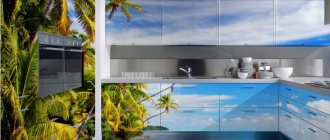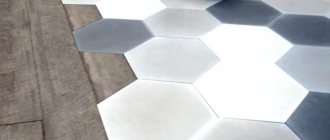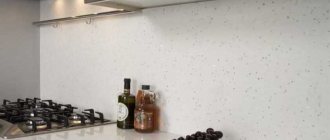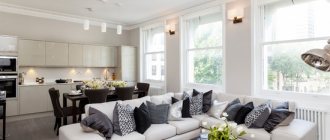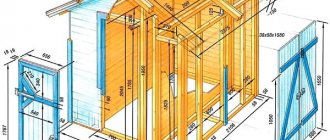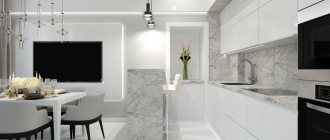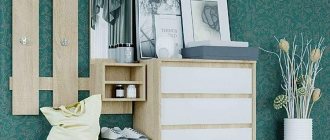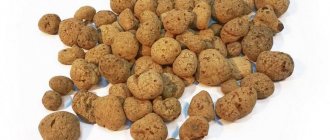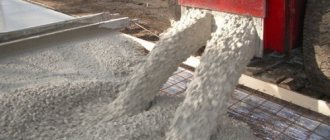Types of roofing and roofing materials, their advantages and disadvantages + Photo
Description: To choose the right material, you need to know how different types of roofing differ from each other. The article compares the features of their application and installation, as well as average prices.
Types of roofing materials for different types of roofs Updated: April 08, 2021 622288
A house without a roof is not a house at all. And to cover it, various types of roofing are used: soft and hard, rolled and piece, flat and profile. Some of them are better suited for country mansions and dachas, others for city houses, and others for outbuildings. To make a specific choice, you need to have an idea of the properties of each roofing material.
In this article: [Hide]
Save time: selected articles delivered to your inbox every week
I confirm my agreement with the privacy policy and terms of the user agreement
Thank you for your trust in our team! Your subscription has been successfully completed.
Dmitry Dubovitsky
Flat membrane roofing
The membranes have a thickness of 0.8 to 2 mm. They can be of three types: PVC, EPDM and TPO. PVC membranes are not environmentally friendly, but they can protect against ultraviolet radiation and fire. EDPM membranes made of artificial rubber reinforced with a polyester mesh are durable and harmless to humans. TPO membranes consist of thermoplastic olefins with mesh reinforcement. They are also environmentally friendly.
Installation. The roof slope can be any, since the membranes are elastic. They are attached to the base (solid) in different ways, the best of which is considered to be hot air welding. On a roof with a large slope, the membrane is attached mechanically using special fasteners. If the slope is more than 100, you can use the ballast method by filling the roof with gravel. On complex roofs, membranes are glued.
Application area. This coating is used on fairly flat roofs of residential or public buildings.
Durability. The service life of the roof is up to 50 years. PVC membrane costs from $5 to $8 per square meter.
+ Pros of membrane roofing:
- The membranes have a large width, allowing you to cover any roof;
- no additional protection from moisture is required - the roof is already waterproof;
- the roof can be covered at any time of the year;
- installation takes place in a short time, repairs are rarely needed;
- puncture resistance is very high.
– Disadvantages of membrane roofing:
- It is necessary to carefully prepare the base, removing all pebbles;
- Solvents and organic oils can damage the roof.
Additional elements
The more perfect the roof, the greater the number of additional elements available for it. These are ridges, valleys, wind and gable elements, ventilation devices, details for passing communications through the roof, and so on. When calculating the budget, it is necessary to take into account not only the price of the base material per m², but also the complex of additional elements. The more complex the roof shape, the greater the number of additions required. The total cost of a simple and complex roof of the same total area can vary quite significantly.
Additional roofing elements
Asbestos cement corrugated sheets (mistakenly called slate)
This is truly cheap and cheerful. Easy to install, looks unsightly. True, they also produce less dull colored products. Sheets of regular UV profile with a wave height of 40 mm and reinforced profiles of 54 mm are produced. CF sheets have a thickness from 4.8 to 5.8 mm, reinforced - from 6 to 7.5 mm. The width of the wave is 15 cm, the weight of a regular sheet is up to 26 kg, reinforced - up to 35 kg. It requires at least two people to install it. The preparation of the roof for the ACVL is minimal: the pseudo-slate weighs relatively little; a sheathing of unedged boards is sufficient. Sometimes you can buy a ridge from additional elements; the rest has to be made of galvanized steel.
Asbestos-cement corrugated sheets
Asbestos-cement sheets are fragile and susceptible to overgrowing with moss, which gradually destroys them. Western doctors and environmentalists claim that asbestos is a terrible poison; they come into contact with it only in spacesuits similar to space ones. When discovered, asbestos-containing materials are disposed of with special precautions, as if they were nuclear waste. Our manufacturers claim that domestic chrysotile asbestos, used for the manufacture of ACVL, is almost beneficial to health.
Russian scientists are modestly silent or say that they have no data on the dangers of chrysotile asbestos. It is considered harmful only in production. The truth is probably in the middle. As long as there is no replacement for “slate” in terms of price, it will be produced. Asbestos-cement products can be called a modern material only because it is actively produced and used in our time. Considering its non-environmental friendliness, we can expect that the production of “slate” will sooner or later be discontinued, as happened in countries with a developed construction industry. https://www.youtube.com/watch?v=qYipa-GWjhk
The service life of asbestos-cement sheets can vary greatly. During snowy winters, thin sheets may crack and require replacement after 10 years. Reinforced ones of maximum thickness with proper care and high-quality lathing will last 40 years. Care consists of cleaning the “slate” from dirt and moss and regularly painting it, which will improve its appearance. Without additional elements and work, roofing material made from ACVL will cost 130-220 rubles, depending on the type of sheet.
Cost of roofing materials
The cost depends on their quality characteristics, service life, and production capabilities. When choosing, you should take into account the thickness of the elements, type and main characteristics. In addition, it is worth adding to the final calculation the cost of installation and possible expenses for spare parts.
Do not forget about the installation of eaves, hydro- and vapor barrier of the roof, as well as the costs of delivery and transportation. The cost of different brands and manufacturers also differs. The price is affected by the presence and composition of the protective coating, shape and color.
If the cost is not in Russian currency, it is worth taking into account fluctuations in the ruble exchange rate relative to foreign currencies.
Price examples
On average, the following prices for roofing material are calculated per square meter, excluding work:
- Metal tiles - from 250 rubles.
- Euroslate - from 850 rubles.
- Corrugated sheeting - from 600 rubles.
- Slate - from 150-200 rubles.
- Ondulin - about 300 rubles per sheet.
- Bituminous shingles - 400-550 rubles (depending on the manufacturer).
- Flexible and soft tiles - from 430 rubles.
- Seam steel covering - from 350-500 rubles, copper - from 1800 rubles.
- Fused roofing - around 120-150 rubles.
- PVC membranes - from 300 rubles.
- Slate tiles - from 3500 to 6000 rubles.
"Evroshifer"
This term is used only in the countries of the former USSR, where few people have seen real slate. The shape of “Euro slate” is similar to corrugated asbestos-cement sheets and has several color options. The most common Euroslate brand in Russia is Ondulin. No wonder, because the French company built a large plant in Nizhny Novgorod. “Euroslate” is a cellulose fiber base impregnated with a bitumen composition using mineral filler, rubber components and stabilizers. It has a bright, rich color and is resistant to ultraviolet radiation.
“Evroshifer”
Ondulin and its analogues are devoid of the main drawback inherent in ACVL - fragility. Euroslate is plastic and bends easily. It can be used even on a not very high-quality, uneven roof. If the base is deformed, it will simply take its shape. This material is loved by European farmers: after all, rafter systems and roofing foundations for agricultural buildings are not always carried out with the same degree of care as for residential and public buildings. Thanks to its flexibility, “Euro slate” can be used to cover curved roofs. It can even be used to cover old roofing over existing roofing.
Corrugated bitumen sheets are very light (only 6.5 kg), the load on the rafter system is minimal. The base is a lathing, as for asbestos-cement sheets. Installation is even simpler; the sheets are cut with a regular hacksaw. necessary additional elements. You can even purchase ready-made, sheet-sized, transparent hatches for access to the roof. Fully clear sheets are also available that are compatible with the basic ones. Another positive property of bitumen slate: it belongs to the group of roofing materials that do not form condensation. There is no need for under-roof film.
Onduline
Onduline provides a 15-year warranty on its products, with an average actual service life of 40 years. Does not require personal care. The cost of one square meter depends on the roof slope and the color of the sheets, excluding additional elements, it is approximately 200-250 rubles. In order to save money, the extensions are sometimes replaced with metal ones. Roofing installation work is also inexpensive, and you can do it yourself.
In essence, this is the same “Euro slate”, but with a profile reminiscent of ceramic tiles and cut into low strips. It has more color options, looks better, and costs more.
Types of roofing materials
Absolutely all houses are covered with roofing. In its manufacture, a variety of materials are used, each of which is intended for a specific type of roof and building. Some of them are used only in the design of country houses and cottages, while others are used in the design of commercial buildings.
In order to choose a roofing material for decorating your home, you should carefully study the characteristics of its various types.
Based on the type of component used in production, the following types of roofing materials are distinguished:
- organic;
- inorganic;
- metal.
The first type of production uses bitumen and polymer components. Bitumen roofing materials last up to twenty-five years. Significant disadvantages include rapid burning and instability to sunlight. As for polymers, they provide a longer service life (up to 70 years) and resistance to high temperatures.
In this regard, inorganic components are much more attractive due to their high resistance to rotting and fire. However, mineral components are susceptible to deterioration under the influence of frequent and sudden temperature changes.
The materials usually contain clay components and slate that absorb moisture. Temperature changes destroy precisely these components, which ultimately leads to damage to the structure of the roof.
Among the main metals used in the manufacture of the base material for the roof are:
- galvanized steel;
- zinc-titanium;
- copper;
- aluminum.
A metal roof is the strongest and most durable. The cost of the material for such a roof is certainly quite high, but the service life is longer, and the characteristics of resistance to weather conditions and temperature changes are better.
Among the characteristics of copper and titanium is the formation of a greenish patina on the surface over time, which gives some originality to the exterior of the house. There is only one downside to a metal roof - noise from wind, rain and hail.
In addition to the components of the roofing material, it is important to consider the type of building. Its purpose directly affects the roofing material.
The market is truly diverse and offers the following options for roofing materials:
- folded;
- piece;
- leafy;
- liquid;
- soft.
Important! Each of the listed species has several subspecies. The range of goods is wide and therefore distributed into groups for easier orientation in the products and their selection.
As for waterproofing roofing materials, they are highly waterproof. There are different types: mastic, roll, piece, etc. The material is based on bitumen or polymers.
There are certain standards in the production of waterproofing materials, such as: heat resistance, water resistance, elasticity, etc. The range of such materials is wide and when choosing it is necessary to start from the needs and type of building.
Corrugated sheet
It has properties similar to metal tiles and is quickly installed. Of all roofing materials, it is most susceptible to avalanches of snow masses. Metal with a thickness of 0.4-1 mm is used, both galvanized and additionally coated with polymer. Convenient for covering long-span buildings. Corrugated roofing sheeting with a polymer coating is somewhat cheaper than metal tiles of the same thickness.
Corrugated sheeting is very slippery, it is advisable to install snow guards
Rating of roofing materials
Among all the roofing materials that are currently on the market, it is quite difficult to identify specific leaders. It all depends on the personal preferences and requirements of the client. But, despite this, the trend in the popularity of some representatives can be traced. So, let's look at the most commonly purchased roofing materials.
IMPORTANT: The most commonly used roofing materials may not be the best among all representatives. The choice mainly depends on the balance between visual qualities, practicality and price.
To begin with, it is worth dividing the types of roofs into pitched and horizontal. The type of roofing material depends on this.
For pitched roofs the rating is as follows:
- Slate.
- Corrugated sheeting is galvanized and polymer coated.
- Metal tiles.
- Euroslate.
- Bituminous shingles.
- Ceramic tiles.
Roofing materials for pitched roofs
Despite the fact that slate has been present as a roofing material on the market for many years, it does not lose its position.
For horizontal roofs, the rating of materials is slightly different. Here the leaders are:
- Roll and liquid bitumen roofs.
- Asbestos cement sheets (flat slate).
- Euroslate.
- Profiled sheeting.
- Ceramic and bituminous tiles.
As you can see, in the creation of roofing for flat roofs, the undisputed leader is roll and liquid materials. This includes roofing felt, all kinds of fiberglass impregnated with bitumen, mastics, etc.
The reason for such an uneven distribution of popularity of roofing materials is determined by their basic qualities. Thus, to create pitched roofs, visual indicators are more important, along with the ability to create tightness. Horizontal surfaces, in turn, must have high water resistance. At the same time, visual qualities can be put into the background.
Roofing materials for horizontal roofs
Seam roofing
Seam roofing is made of metal similar to that used in the manufacture of metal tiles. Plates are produced with a pre-prepared seam connection. When installing on the roof, the fold must be snapped in place and bent completely. A properly assembled seam roof is absolutely sealed: there are no sheet overlaps, and the seam itself does not allow water to pass through. In addition, the design makes it possible to reduce the number of fastening elements (and holes from them) located on the roof surface to a minimum. Other properties and price are similar to metal tiles. Labor costs for installation are slightly higher.
Seam roofing
Cink Steel
Roofing made of galvanized steel of the traditional type is being used less and less. It is supported by high tightness and a competent storm water drainage system, in which there is no need for horizontal storm drain elements. Unfortunately, installing such a roof in compliance with all the rules is labor-intensive; the sheets have to be cut and the folds bent at the construction site. In addition, in order to ensure the required service life of 40 years, after 4-6 years of service, it is necessary to clean the metal every other year and coat it with oil paint. Taking into account cutting, galvanizing with a thickness of 0.7 mm costs approximately 250 rubles.
Galvanized steel roofing
Metal tiles
Metal tiles are made from thin profiled galvanized sheet steel, coated with a protective and decorative coating. Metal with a thickness of 0.4-0.7 mm is used, usually 0.45 or 0.5 mm. The roof is very light - only 5 kg/m². A rigid profile that imitates natural tiles was invented by the Finn Paavo Ranilla in 1961. The first samples of metal tiles were painted with oil paints. Today these are more advanced polymer compositions. In addition to the basic colors, you can order any of the thousands of shades from the RAL catalog. The lion's share of metal tiles offered on the Russian market in CIS countries is locally produced. The bulk of products have a budget polyester coating, semi-gloss or matte. Material is also produced with more durable and expensive coatings from plastisol, polyurethane and polyvinylidene fluoride.
Metal tile
The technology for installing a metal tile roof is quite simple; the requirements for preparing the base are minimal (sheathing is required). Manufacturers offer a huge number of additional elements and storm systems in the color of the roof. For complex roofs, you can order any parts according to individual sizes. Profiled metal sheets are strong, non-flammable and quite durable. Manufacturers provide a guarantee of 10-15 years, the actual service life is 30-50 years.
The disadvantages include the noise of the coating during rain and high condensation, which is inherent in all metal roofs. A square meter of metal tiles without additions will cost an average of 200 rubles for polyester and up to 450 rubles for other types of coating.
Composite metal tiles
Further development of metal tiles. It has a more relief profile, ridge elements that reliably imitate natural tiles or wood shingles. The dimensions of the sheets are small in height, per row. The polymer coating is protected on top by a layer of colored stone chips, filled with a layer of transparent polymer. For primary protection of steel, a reliable aluminum-zinc coating is used.
Unlike conventional metal tiles, composite tiles do not make noise when it rains. The price is high - 750-1100 rubles/m². But composite tiles will last a hundred years, or even more.
Composite metal tiles
Flexible bitumen shingles
A beautiful and durable material, consisting of a base impregnated with bitumen and sprinkled with stone chips, was invented in the middle of the last century in the USA. At first it imitated the wooden shingles so beloved by Americans, but today it has acquired its own aesthetic meaning and resembles shingles or scales (lamella armor, depending on what you like).
The current bitumen shingles are a multilayer material based on fiberglass, impregnated with high-quality modified bitumen containing powdered mineral filler. The upper part is covered with a protective and decorative coating of colored stone chips. The self-adhesive layer is located at the bottom. Leading manufacturers offer a wide variety of tile shapes and colors. The starting strip, ridge and valley are made from the same material as the tile itself; the remaining additional elements are made from galvanized steel coated with polymer.
Flexible bitumen shingles
Unlike other piece or sheet roofing materials, properly installed asphalt shingles provide a single waterproof roof covering without any gaps. At the same time, it is flexible, which allows it to withstand deformations of the base. In addition, there are no fasteners or holes on the surface. Flexible tiles are suitable for roofing work on roofs with large bending radii, the minimum recommended slope is 12°, and less is possible if simple conditions are met.
The base for bitumen shingles must be prepared carefully: it must be a flat, solid base made of sheet materials (OSB, moisture-resistant plywood) or edged boards. The tightness of the roof requires mandatory ventilation of the under-roof space. Laying tiles is quite simple, but requires care.
The service life of high-quality bitumen shingles is at least half a century. Domestic Ruflex, for example, is guaranteed for 35 years. Costs from 280 to 420 rubles per m².
Unique properties, attractive appearance and reasonable price have made bitumen shingles popular in all corners of the world. In the USA and Canada, the vast majority of pitched roofs are covered with flexible tiles. Russia is no exception, where two of its own largest manufacturers appeared.
Ceramic tiles
The favorite roofing covering in European countries. Fired ceramics protected roofs several thousand years ago, but today this material is perhaps even more in demand and relevant. The greatest perfection in its production was achieved by craftsmen from those regions where pure fusible clays are mined: Bavaria, Italy, Greece, and the southern provinces of Spain. In our country, clay deposits of truly suitable quality are currently unknown. High-quality ceramic tiles are brought to Russia and the markets of the CIS countries from Western Europe. True, it produces its own, but it does not reach the level of imported products and is not widespread.
Ceramic tiles
There are many models of tiles, among them there are two main types: grooved (volumetric) and strip (flat). Manufacturers offer a variety of additional ceramic elements for all possible occasions. In addition to natural, the surface of the tiles can be engobed (metal oxides are added to the composition, changing color and texture) and glazed. Tile is the heaviest of roofing materials (up to 60 kg/m²), the rafter system must be very strong. But the coating is completely silent, does not form condensation, does not overheat and is ventilated.
High demands are placed on the construction of the supporting structure and the preparation of the roof (sheathing), especially in terms of strength. Installation of the tiles themselves is also quite labor-intensive and requires care, but their service life is very long. The literature indicates that it is at least one hundred years. In Europe you can see historical buildings that have stood under tiled roofs for half a millennium. The price per square meter of ordinary high-quality ceramic tiles starts from 900 rubles/m².
Concrete tiles
It is made from a cement-sand mixture with coloring and modifying additives. The technology is similar to the production of paving slabs using the semi-dry pressing method. The shape of concrete tiles completely imitates ceramic tiles and has the same wide range of additions. The concrete surface can be further processed, giving it better hydrophobicity and an attractive appearance. Concrete tiles are as heavy as natural ones. It costs much less than ceramics: 300-500 rubles/m², but it will not last as long (about 50 years).
Concrete tiles
Tiles made of other materials
From time to time, individual companies try to enter the roofing materials market with new products, in particular, tiles made of composite thermoplastic. Practice has shown that the stated characteristics and service life do not correspond to the actual ones. There were also attempts to establish the production of tiles from autoclaved silicate concrete, but this material did not take root.
Zinc-titanium roofing
In developed countries, roofing made of steel with a zinc-titanium coating is quite common. As a rule, this is a rebated design. The coating is extremely durable, with a service life of hundreds of years. In Russia it is rare due to the high cost, the need for careful installation and the “lead” patina - we like it brighter.
Zinc-titanium roofing
Copper roofing and aluminum
Copper roofing can be made in different forms: sheet, flake tiles, profiled. Very expensive, very beautiful, almost forever.
Copper roofing and aluminum
The material - aluminum, which was once predicted to revolutionize the roofing business, has not really caught on. Despite its obvious advantages, the main one being the absence of corrosion, it is rare. The reason is most likely its unassuming appearance and excessive softness.
Slate roofing
Roofing slate is a durable sheet that has an ideal set of qualities for use as a roofing material.
Roofs covered with slate began to be used in the Middle Ages, as roofing material for the roofs of elite buildings of that time. One of the main advantages of slate is the ability to cover a roof of absolutely any shape. Slate has a dark gray hue and an oily sheen that gives any roof an antique look. When creating picturesque ornaments on the roof, the use of green and burgundy slates is widespread.
The advantages of slate are obvious:
- the average service life of a slate roof is about two hundred years; - mass of a square meter of material with a thickness of 0.5-1 cm - 40-50 kg; — high bending strength – about 60 megapascals; — high level of noise absorption; - any available roof geometry; — versatility, slate can be used not only as a roofing material, but also as a facing material, and also, with rare exceptions, as a structural material.
Slate roofing
When laying slate roofing, three classical methods are used - English, French and German. The differences in the methods lie solely in the details regarding the shape of the plates used, as well as the angles of their placement, and each method has its own undeniable advantages.
The German method involves laying the slabs at an angle of 45 degrees to the horizontal, this allows you to increase the transverse dimensions of the tiles and fasten them with nails per board. The advantages of this method are the prevention of cracking of slate in the event of temperature or other displacements of the sheathing strips. In addition, the method allows, due to the arrangement of the slabs, to control the flow of water, directing it along the inclined edge to the center of the bottom tile, this greatly increases the speed of water flow from the roof, not allowing water to linger on a wide part of the slate slabs
The French method is characterized by the use of equilateral tiles with cut side corners.
The English method differs in that it uses slabs with a rectangular shape, which increases the overlap of the tiles and significantly reduces the risk of water getting deep into the sheathing.
Traditional roofs in a new interpretation
Such traditional types of roofs as wooden shingles and shingles, reed and thatch are experiencing a rebirth. In technologies that involve a high share of manual labor, some production processes have been automated.
Shingle Roof
These types of roofs are not cheap, labor intensive to install, and will not become widespread. But they will not sink into oblivion; the demand for them, although limited, is stable.
Reed roofing
So, we have looked at modern roofing materials for pitched roofs. What choice should you make when building a country house? If you have a serious budget, ceramic tiles and slate slate cannot compete. For budget construction, flexible bitumen shingles are good. It is also best suited for complex roofs. Metal tiles and ondulin are a little cheaper. They are also the easiest to install if the roof is installed independently. Each roofing material has its own disadvantages and advantages, corresponding to its price.
Piece roofing materials
Ceramic tiles - very beautiful, but heavy and expensive
This roofing material is one of the oldest types of roofing materials, along with wood shingles and slate. To make tiles, clay is fired at a temperature of one thousand degrees, after which it becomes hard and durable, and the color becomes brown with a reddish tint. Some types of tiles are glazed before firing to increase water-repellent properties. Finished tiles (weighing 2 kg or more) have a length and width of 30 cm.
There are several types of clay tiles.
Here are the main ones:
- Strip flat tiles;
- strip groove tiles;
- stamped groove tiles;
- ceramic row tiles;
- single-wave tiles;
- two-wave tiles;
- grooved tiles.
Installation. It is preferable to construct a tiled roof with a roof slope of at least 25 and no more than 600. If it is less than 220, then it is imperative to provide a waterproofing layer and good ventilation. And a slope exceeding 600 will require more screws or nails for fastening. The individual elements (they are placed with the upper tiles overlapping the lower ones) are connected with special locks. The finished roof has the appearance of a continuous scale, so it has less chance of leaking. The tiles are attached to the sheathing with nails through special holes.
Application area. Use this roofing to cover roofs in houses made of brick, wood, and stone. The number of floors does not matter.
Durability and price. The durability of such a roof is impressive - it can last 150 years without repair. However, not everyone can afford such luxurious coverage. After all, its price per square meter ranges from $20 to $50.
+ Advantages of ceramic tiles:
- Economical operation - prevention and cleaning of gutters with valleys is needed only once a year;
- good sound insulation - rain will not interfere with sleeping under a tiled roof;
- non-flammability;
- corrosion resistance;
- frost resistance (at least 1000 freezing cycles);
- aesthetics, variety of tones and profiles;
- A tile roof is porous; it can “breathe” by evaporating water.
– Disadvantages of ceramic tiles:
- The weight of the roof is considerable - thicker or more frequent rafters are needed;
- the tiles are fragile;
- It is problematic to cover a complex roof with it - additional fasteners, sheathing, and insulation will be required;
- high price.
Sand-cement tiles are lighter than clay tiles, but do not last as long
This piece covering is made from a solution of sand and cement, which is not fired, but pressed under pressure. The dye is iron oxides, which make these tiles look like ceramic. Either glaze is applied on top or there is no coating. The surface is made smooth or with a convex profile pattern. This roof weighs from 35 to 40 kg (one square meter).
Installation. The optimal slope for installation is from 20 to 600. Fastening to the sheathing occurs in rows, through the holes on the tiles. In this case, a “bandage” is made equal to one-half the width of the tile. This is called the shift of a row relative to the neighboring one. The rafters are taken with a section of 5 by 15 cm, and the distance between them is from 60 to 90 cm. In addition to the sheathing, a layer of waterproofing is required.
Application area. This roof, like the previous one, can be used in houses made of various materials and with any number of floors.
Durability and price. Of course, it won’t last a hundred years, but the manufacturer gives a thirty-year guarantee. But the price of cement-sand tiles (from $10 to $20 per square meter) is lower than that of clay ones. And outwardly they are almost the same.
+ Advantages of sand-cement tiles:
- resistance to chemical aggression;
- resistance to sunlight;
- frost resistance (1000 freezing cycles).
– Disadvantages of sand-cement tiles:
- Greater thickness compared to ceramic tiles - at least a centimeter.
- up to a tenth of the material can be lost by breaking during careless transportation;
- the price is still high.
Composite tiles
This fairly new material on the Russian market consists of modules made of steel sheet with an aluminum-zinc coating and an outer surface made of quartz or basalt chips. The result is a believable imitation of ceramic tiles with good performance, but at a lower price.
The service life of composite tiles reaches 100 years, which is much longer than that of metal tiles, of which they are an improved version. Its heat and sound insulation values are also significantly higher. Composite tiles are light, durable, beautiful, and come in a variety of shapes and colors.
The disadvantages of the material include the rather high (compared to metal tiles) cost of the coating itself and its installation. The price of composite tiles on average ranges from 500 to 700 rubles per sq.m.
Soft bitumen shingles
This is a fiberglass base with a double-sided bitumen coating of improved heat resistance. A layer of basalt granulate is applied to the outer surface, giving it a resemblance to natural tiles.
This soft roofing material is suitable for any roof shape, including domed roofs, with a minimum pitch of 12°. Overlapping modules are sintered at high temperatures, which guarantees protection against leaks. The installation technology is simple and does not require the use of special tools, but installation must be carried out on a solid base.
Soft tiles have many advantages. It is very light, resistant to atmospheric influences, fungus, chemical agents, provides excellent heat and sound insulation, moisture protection, and can withstand wind loads and temperature changes. When covering roofs with bituminous shingles, almost no waste is generated. In terms of decorative characteristics, this material is perhaps not inferior to the ceramic prototype.
As for the disadvantages, the main one is the need to strictly follow the installation technology in order to avoid deformation of the tiles. Sintering of the sheets complicates partial repairs.
The cost of bitumen shingles is from 250 rubles per 1 sq.m.
Slate roofing is a rare luxury coating
Nature itself produces this beautiful material using pressure and heat. Slate roofs can be seen on some ancient castles in Europe. However, if you wish, you can also buy slate tiles from us with a thickness of 4 mm and a weight of up to 25 kg (per square meter). It is made by hand, 15 or 30 cm wide and 20 or 60 cm long.
The roof is covered with slate roofing.
Installation. Slate can be laid on roofs with a slope of 250. The sheathing is made from rafters, the cross-section of which is 4 by 6 cm. We determine its pitch by dividing the length of the tile in half and slightly reducing the resulting number. Nails (copper or galvanized) for fastening are taken 9 or 10 cm long. For each tile, take two nails, on the edge and with a slope of more than 400 - three nails.
The principle of installation of slate roofing.
Durability and price. The service life of a slate roof is from 100 to 150 and even 200 years (provided the base is properly constructed). One square meter of material costs $65-100.
+ Advantages of slate roofing:
- Huge service life;
- exclusivity, wonderful appearance;
- color fastness, UV protection;
- water resistance, frost resistance, fire safety.
– Disadvantages of slate roofing:
- The price is too high.
